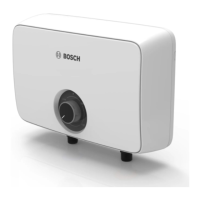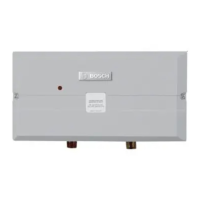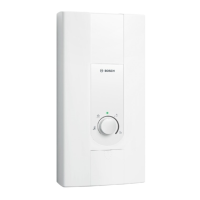8
|
Installation Manual
Bosch Tronic 6100 C Electric Tankless Water Heaters - BTC 724001301 A (08.2022)
2.4.2 Centralized Location
Choose a location for the water heater as centralized to the piping and electrical
system as possible. Also, locate the water heater and domestic water piping where
it will not be exposed to freezing temperatures. All piping should be insulated.
Additionally, place the water heater so that the drain, controls, and inlets/outlets
are easily accessible.
To save on heating costs and improve energy effi ciency keep the distance
between the water heater and fi xtures to a minimum to reduce heat loss
from excess piping and keep friction loss at a minimum. Ensure all water
heater piping is properly insulated to minimize heat loss.
In the State of California, the water heater must be braced, anchored,
or strapped to avoid moving during an earthquake. Contact local utilities
for code requirements in your area. Visit http://www.dsa.dgs.ca.gov or
call 1-916-445-8100 and request instructions.
WARNING: FIRE, EXPLOSION
This water heater must not be located near fl ammable
liquids such as gasoline, butane, liquefi ed propane,
adhesives, solvents, paint thinners, etc., as the controls of
this water heater could ignite these vapors and cause an
explosion resulting in property damage, severe personal
injury, or death.
2.4.3 Replacing an Existing Water Heater
If the water heater is to replace an existing water heater, check for and correct any
existing system problems such as:
System leaks
Location that could cause the system and water heater to freeze and leak
3 Water Quality Requirements
CAUTION: PROPERTY DAMAGE, PRODUCT DAMAGE
Chemical composition of the water supply may aff ect
effi ciency and cause severe damage to the appliance and
associated equipment. Water quality must be professionally
analyzed to determine whether it is necessary to treat the
water. Various solutions are available to adjust water quality.
Adverse water quality will aff ect the reliability of the system.
In addition, operating temperatures above 135°F will
accelerate the build-up of lime scale and possibly shorten
appliance service life. Failure of an appliance due to lime
scale build-up, low pH, or other chemical imbalance IS NOT
covered by the warranty.
The water must be potable, free of corrosive chemicals, sand, dirt, and other
contaminates, and meet the manufacturer’s requirements. It is up to the installer
to ensure the water does not contain corrosive chemicals or elements that can
damage the heat exchanger. Potable water is defi ned as drinkable water supplied
from utility or well water in compliance with EPA secondary maximum contaminant
levels (40 CFR Part 143.3). If the water contains contaminants higher than
outlined by the EPA and the manufacturer, water treatment is recommended and
additional, more frequent maintenance may be required. If you suspect that your
water is contaminated in any way, discontinue use of the appliance and contact an
authorized technician or licensed professional.
Contaminant Maximum Allowable Level
pH 6.5 - 8.5
Total Dissolved Solids (TDS) Less than 500 mg/L
Free CO2 Less than 500 mg/L
Total Hardness Less than 200 mg/L
Aluminum Less than 0.2 mg/L
Chloride Less than 250 mg/L
Copper Less than 1.0 mg/L
Iron Less than 0.3 mg/L
Manganese Less than 0.05 mg/L
Zinc Less than 5 mg/L
Table 3
Water Quality Requirements
NOTICE: PRODUCT DAMAGE
Failure of electric elements due to lime scale build-up on the
heating surface, low pH, or other imbalance IS NOT covered
by the warranty.
Hard water, water containing mineral concentration of over
250 mg/liter, may cause a scale build up that can damage the product.
In case of hard water it is recommended to use an anti-scale treatment.
Damage caused by scale is not covered by the warranty.
To promote appliance service life, it is strongly recommended to follow
the maintenance procedures in this manual.

